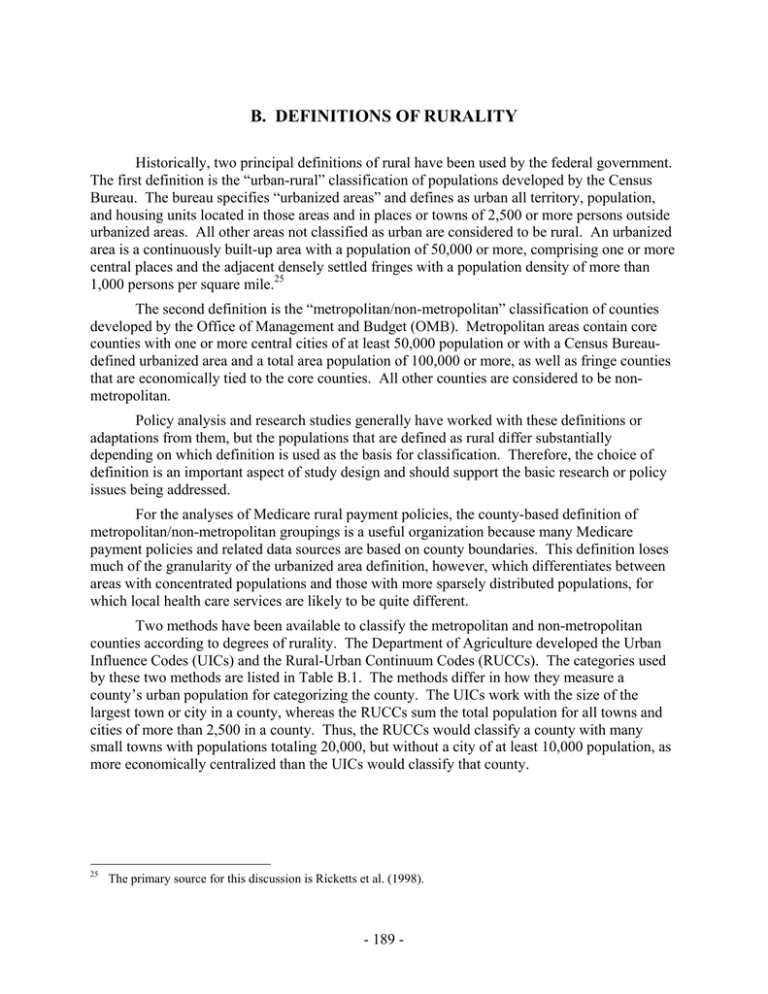B. DEFINITIONS OF RURALITY
advertisement

B. DEFINITIONS OF RURALITY Historically, two principal definitions of rural have been used by the federal government. The first definition is the “urban-rural” classification of populations developed by the Census Bureau. The bureau specifies “urbanized areas” and defines as urban all territory, population, and housing units located in those areas and in places or towns of 2,500 or more persons outside urbanized areas. All other areas not classified as urban are considered to be rural. An urbanized area is a continuously built-up area with a population of 50,000 or more, comprising one or more central places and the adjacent densely settled fringes with a population density of more than 1,000 persons per square mile.25 The second definition is the “metropolitan/non-metropolitan” classification of counties developed by the Office of Management and Budget (OMB). Metropolitan areas contain core counties with one or more central cities of at least 50,000 population or with a Census Bureaudefined urbanized area and a total area population of 100,000 or more, as well as fringe counties that are economically tied to the core counties. All other counties are considered to be nonmetropolitan. Policy analysis and research studies generally have worked with these definitions or adaptations from them, but the populations that are defined as rural differ substantially depending on which definition is used as the basis for classification. Therefore, the choice of definition is an important aspect of study design and should support the basic research or policy issues being addressed. For the analyses of Medicare rural payment policies, the county-based definition of metropolitan/non-metropolitan groupings is a useful organization because many Medicare payment policies and related data sources are based on county boundaries. This definition loses much of the granularity of the urbanized area definition, however, which differentiates between areas with concentrated populations and those with more sparsely distributed populations, for which local health care services are likely to be quite different. Two methods have been available to classify the metropolitan and non-metropolitan counties according to degrees of rurality. The Department of Agriculture developed the Urban Influence Codes (UICs) and the Rural-Urban Continuum Codes (RUCCs). The categories used by these two methods are listed in Table B.1. The methods differ in how they measure a county’s urban population for categorizing the county. The UICs work with the size of the largest town or city in a county, whereas the RUCCs sum the total population for all towns and cities of more than 2,500 in a county. Thus, the RUCCs would classify a county with many small towns with populations totaling 20,000, but without a city of at least 10,000 population, as more economically centralized than the UICs would classify that county. 25 The primary source for this discussion is Ricketts et al. (1998). - 189 - Table B.1 Two Classification Methods for Metropolitan and Non-Metropolitan Counties Code Definition Urban Influence Codes 1 Large central and fringe counties of metropolitan areas of 1 million population or more 2 Small counties in metropolitan areas of fewer than 1 million population 3 Adjacent to a large metropolitan area with a city of 10,000 or more 4 Adjacent to a large metropolitan area without a city of 10,000 or more 5 Adjacent to a small metropolitan area with a city of 10,000 or more 6 Adjacent to a small metropolitan area without a city of 10,000 or more 7 Not adjacent to a metropolitan area and with a city of 10,000 or more 8 Not adjacent to a metropolitan area and with a town of 2,500 to 9,999 9 Not adjacent to a metropolitan area and without a town of at least 2,500 Rural-Urban Continuum Codes 0 Central counties of metropolitan areas of 1 million population or more 1 Fringe counties of metropolitan areas of 1 million population or more 2 Counties in metropolitan areas of 250,000 to 1 million population 3 Counties in metropolitan areas of fewer than 250,000 population 4 Adjacent to a metropolitan area, urban population of 20,000 or more 5 Not adjacent to a metropolitan area, urban population of 2,000 or more 6 Adjacent to a metropolitan area, urban population of 2,500 to 19,999 7 Not adjacent to a metropolitan area, urban population of 2,500 to 19,999 8 Adjacent to a metropolitan area, less than 2,500 urban population 9 Not adjacent to a metropolitan area, less than 2,500 urban population SOURCE: Ricketts et al. (1998). Rural health researchers tend to prefer the UICs to classify degrees of rurality for nonmetropolitan counties because the availability of health service resources is strongly affected by the presence or absence of a city of substantial population. We chose to use UICs for this analysis for this reason. However, we recognize that the use of county-level boundaries sacrifices the ability to measure variations in the populations living in towns of at least 2,500 within each non-metropolitan county, which weakens our ability to capture the effects of related variations in health services and utilization. The U.S. Department of Agriculture (USDA) recently released a new definition of “urban” and “rural” areas called the Rural-Urban Commuting Area (RUCA) codes, which were developed jointly by USDA’s Economic Research Service and the HHS Office of Rural Health Policy. Like the UIC and RUCC systems, the RUCA codes are based on measures of urbanization, population density, and daily commuting. However, this set of 10 codes— three codes for metropolitan areas and seven for non-metropolitan areas—uses the much smaller census tract as its base unit instead of the county and metropolitan area. These codes are listed in Table B.2. The primary codes refer to the primary or single largest commuting share of a census tract. These codes are subdivided “to identify areas where primary flow is local but over 30 percent commute in a secondary flow to a larger area core” (Economic Research Service [ERS] web site on RUCA codes). The seven non-metropolitan codes form a unidimensional scale of rurality. Analysts are just beginning to experiment with the RUCA codes, and we hope to explore their applicability in subsequent analyses for this project. - 190 - Additional information about the various coding methods for classifying areas based on degree of rurality may be found at http://www.ers.usda.gov. Some addresses are listed here for reference. What Is Rural? Urban Influence Codes Rural-Urban Continuum Codes Rural-Urban Commuting Area Codes Urbanized Area http://www.ers.usda.gov/briefing/rurality/WhatisRural http://www.ers.usda.gov/briefing/rurality/UrbanInf http://www.ers.usda.gov/briefing/rurality/RuralUrbCon http://www.ers.usda.gov/briefing/rural/data/desc.htm http://www.ers.usda.gov/briefing/rural/data/urbanar.htm - 191 - Table B.2 Rural-Urban Commuting Area (RUCA) Codes Primary Code 1 2 3 4 5 6 7 8 9 10 99 SubCode Definition Metropolitan-area core: primary flow within an urbanized area (UA) 1.0 No additional code 1.1 Secondary flow 30% to 50% to a larger UA Metropolitan-area high commuting: primary flow 30% or more to a UA 2.0 Primary flow to a 1.0 UA 2.1 Primary flow to a 1.1 UA 2.2 Combined flows to two or more UAs adding to 30% or more Metropolitan-area low commuting: primary flow 5% to 30% to a UA 3.0 No additional code Large town core: primary flow within a place of 10,000 to 49,999 4.0 No additional code 4.1 Secondary flow 30% to 50% to a UA Large town high commuting: primary flow 30% or more to a place of 10,000 to 49,999 5.0 Primary flow to a 4.0 large town 5.1 Primary flow to a 4.1 large town Large town low commuting: primary flow 5% to 30% to a place of 10,000 to 49,999 6.0 No additional code Small town core: primary flow within a place of 2,500 to 9,999 7.0 No additional code 7.1 Secondary flow 30% to 50% to a UA 7.2 Secondary flow 30% to 50% to a large town 7.3 Secondary flow 5% to 30% to a UA 7.4 Secondary flow 5% to 30% to a large town Small town high commuting: primary flow 30% or more to a place of 2,500 to 9,999 8.0 Primary flow to a 7.0 small town 8.1 Primary flow to a 7.1 small town 8.2 Primary flow to a 7.2 small town 8.3 Primary flow to a 7.3 small town 8.4 Primary flow to a 7.4 small town Small town low commuting: primary flow 5% to 30% to a place of 2,500 to 9,999 9.0 No additional code 9.1 Secondary flow 5% to 30% to a UA 9.2 Secondary flow 5% to 30% to a large town Rural areas: primary flow to a tract without a place of 2,500 or more 10.0 No additional code 10.1 Secondary flow 30% to 50% to a UA 10.2 Secondary flow 30% to 50% to a large town 10.3 Secondary flow 30% to 50% to a small town 10.4 Secondary flow 5% to 30% to a UA 10.5 Secondary flow 5% to 30% to a large town Not coded: Tracts with little or no population and no commuting flows - 192 -





